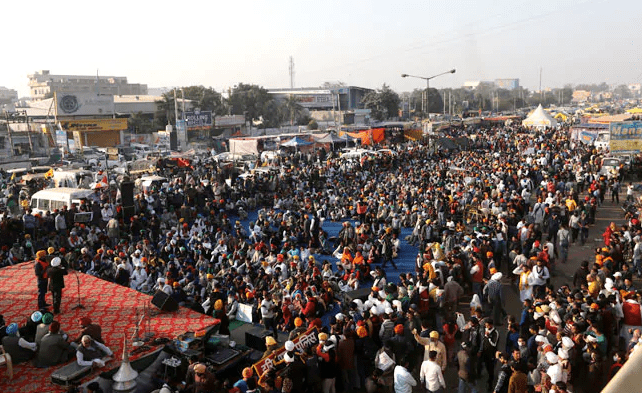Recently, Indian farmers’ protests have escalated. According to the Times of India on December 21, farmers will relay to carry out “streat protests” against the government’s new agricultural reform bill.
In May this year, India’s Finance Minister Hitalaman announced an economic rescue and reform plan, which aims at the abolition of the “middleman system” for agricultural product acquisitions in the agricultural sector.
In September, the government passed the Agricultural Trade and Commerce (Enhancing and Promotion), the Farmer Price Guarantee and Agricultural Services Act and the Necessities (Amendment) Bill, and three reform bills became the trigger. Since November 26, Indian farmers have held protests in New Delhi and other places despite the impact of the epidemic.
Why don’t farmers buy it?
Sporadic protests have occurred in Punjab and Haryana in May this year. Three reform bills passed in September added fuel to the fire, causing the situation to get out of control.
Zhang Shujian, an assistant researcher at the South Asian Research Institute of the China Institute of Modern International Relations, said in an interview with this newspaper that the reason for farmers’ anxiety is the loss of “negotiating power”. “Before, farmers and distributors have formed a community of interests, and farmers have formed a unified bargaining power through distributors to obtain stable guarantee.
Although from the perspective of free market, an extra layer of “middlemen” will “eat” more benefits, farmers believe that the current system can protect their interests. If the reform is carried out, farmers will face directly to large enterprises and consortia with monopoly power, resulting in the loss of bargaining power, which is why farmers are unwilling to be involved in the free circulation market.
Farmers’ worries are not groundless. The Indian government has long had a “exced record”. According to the Lookout Think Tank, after the implementation of the agricultural liberalization reform in Bihar in 2006, grain traders as capitalists sold in large quantities when the grain harvest was sold at a low price and when the harvest failed, seriously weakening the income expectations of the majority of small and medium-sized farmers.
Therefore, a new round of agricultural reform directly pokes the pain points of farmers, resulting in farmers’ increasing distrust of the government.
There are also political reasons for this distrust. Zhang Shujian believes that the Indian government has previously achieved certain results in obtaining the support of farmers by releasing subsidies, reducing or exempting loans and other means of “smashing money”.
However, affected by the epidemic this year, the finances were unable to afford it and had to give up their previous commitments, which caused farmers’ dissatisfaction.
Behind the contradictions and disputes
At present, the Indian government has held six rounds of negotiations with farmers’ representatives, but all of them have failed.
Although the government has repeatedly stressed that intermediaries harm the interests of Indian farmers and should be “given farmers corresponding freedom”, this statement obviously does not reconcile.
According to Reuters, farmers’ representatives said that Modi was “privatizing” agriculture and that enterprises would become the ultimate profiteers.
The increasingly intensification of contradictions is a complex representation of the interaction of various factors in Indian society for a long time.
The first reason is regional and religious issues. Ponbang and Habang farmers were the main forces of the protest.
Zhang Shujian said that the Punjab region is relatively special, with a high political and economic status and a distinct religious color of farmers. First of all, since the “Green Revolution”, Punjab has been the most important commodity grain production base in India, where farmers have a higher status than other provinces.
Secondly, the population of Punjab is mainly Sikhs. In this protest, they showed a highly organized state. Moreover, Sikhs also have strong influence overseas. According to Reuters, most Indian Sikhs living abroad come from domestic agricultural families.
They marched in front of Indian embassies in the United States, the United Kingdom, Canada, Australia and other places to demonstrate in solidarity with domestic protests.
The second reason is social polarization. The Economist published an article in December saying that the polarization between rich and poor in India has intensified, with a shrinking economy and tens of millions of people falling into poverty, and on the other hand, a large amount of wealth flowing to the richest 1% of Indian society.
Zhao Gancheng, a researcher at the Shanghai Institute of International Studies, said in an interview with this newspaper: “India’s economy is in the take-off stage, and there is bound to be a widening gap between rich and poor.
With the increase of the proportion of secondary and tertiary industries, the proportion of agriculture decreases, but the number of farmers is still large, so if India can’t solve the agricultural problem well, its industrialization development will also be inhibited.
Where to go under heavy pressure?
With the economic downturn and the impact of the epidemic, it is unwise for the Indian government to try to implement reforms at a time of domestic and foreign difficulties.
At present, the two sides are still deadlocked. Zhang Shujian said: “On the one hand, the peasants who demonstrated resolutely made it clear that the government would never give in without withdrawing the bill; on the other hand, the ruling party in a strong position.
Since taking office, India’s current government has not yet set a precedent to withdraw it as soon as a bill is introduced, and it is difficult to get off. There is a greater likelihood of continuing the deadlock in the short term.”
“It has now evolved into a direct opposition between the Sikh community and the Hindu nationalism that it represents,” said Zhang Shujian.
“The Indian Party is a right-wing party, and ethnic conflicts within the country have been intensifying since it came to power.”



